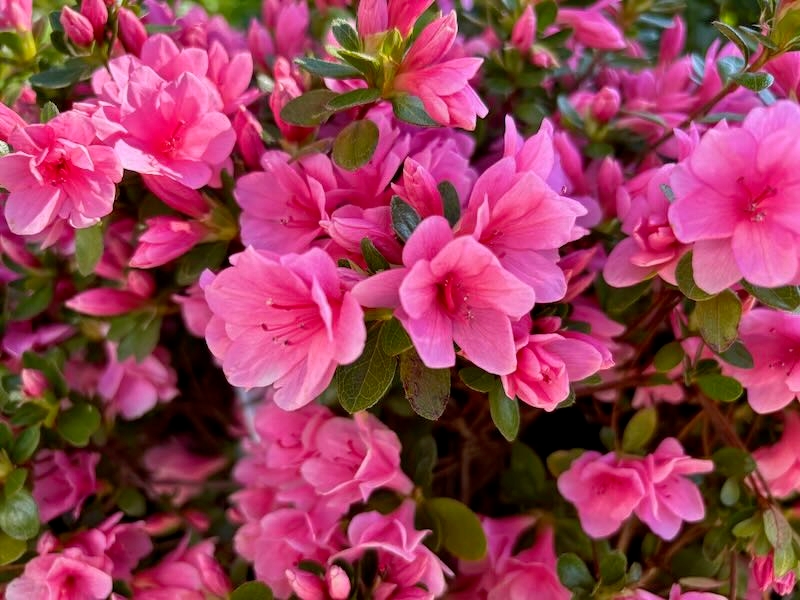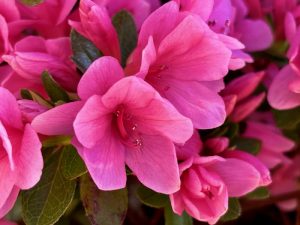A Delicate Spring Awakening: Azalea indicum ‘Coral Bells’
With its radiant coral-pink blossoms and evergreen foliage, Azalea indicum ‘Coral Bells’, Azalea Kurume ‘Coral Bells’, Rhododendron indicum ‘Coral Bells’ or Coral Bells Azalea, brings the gentle promise of spring to life in garden landscapes. This beloved cultivar is one of the early bloomers among azaleas, filling the late winter and early spring air with soft color and lush texture. A member of the Ericaceae family, this compact shrub is not only aesthetically charming but also surprisingly versatile in a wide variety of shaded garden settings.
Profile of a Classic: The Origins and Character of Azalea indicum ‘Coral Bells’
As a cultivar of the Kurume Azaleas, Azalea indicum ‘Coral Bells’ carries a heritage of meticulous hybridization. These hybrids, originally bred in Japan and introduced to the West in the early 20th century, are known for their prolific blooming and dense, mounding growth. ‘Coral Bells’ maintains these characteristics with enthusiasm. Its coral-pink double blooms, measuring about 1.25 inches (3.2 cm) across, appear in dazzling masses that often cover the plant so densely that the foliage is almost hidden.
Reaching a mature height between 2 and 6 feet (0.6 to 1.8 meters) and spreading from 3 to 6 feet (0.9 to 1.8 meters) wide, this shrub is well-suited to foundation plantings, borders, or containers. Its dense, evergreen habit allows it to serve as a visual anchor in the garden throughout the year, with foliage that may develop red or burgundy tones in the cooler months.
Ideal Conditions for Azalea indicum ‘Coral Bells’
To thrive, Azalea indicum ‘Coral Bells’ requires a few key growing conditions. It prefers partial shade, ideally receiving 2 to 6 hours of dappled or filtered sunlight each day. Morning sun with afternoon shade is perfect, especially in hotter climates. Full sun can lead to leaf scorch, while deep shade can reduce bloom production.
The soil should be well-draining, acidic (pH below 6.0), and high in organic matter. A loamy mix amended with compost or leaf mold works beautifully. This azalea will not tolerate soggy conditions, and heavy clay or compacted soil can promote root rot, especially Phytophthora, to which this cultivar is particularly susceptible.
Regular watering is essential, particularly during the establishment period and in dry spells. Mulching with pine bark or pine needles helps retain soil moisture, suppress weeds, and maintain that all-important soil acidity.
A Show of Coral Charm
The coral-pink flowers of ‘Coral Bells’ are undoubtedly its most striking feature. These blooms appear in mid to late spring, often blanketing the shrub in soft color. The double-petaled flowers have a bell shape and appear in clusters, creating a massed floral effect that is both delicate and intense.
Occasionally, this cultivar may produce a lighter secondary bloom in fall, especially in temperate regions. The flowers not only delight the eyes but also attract pollinators such as bees and butterflies, making it a suitable addition to pollinator gardens.
Each flower is about 1.25 inches (3.2 cm) in diameter, with layered petals that give it a ruffled texture. Though the blooms are unscented, their profusion and vivid coloration ensure a captivating spring display.
Using Azalea ‘Coral Bells’ in Landscape Design
This azalea is ideal for shaded or woodland gardens, either as a solo specimen or grouped in masses under tree canopies. Its compact growth habit makes it suitable for borders, foundation plantings, and even low hedges. The evergreen foliage provides year-round interest, and its seasonal flower show brings a moment of celebration to spring landscapes.
Container planting is another excellent use for ‘Coral Bells,’ especially in patios or courtyard gardens where soil conditions may not be ideal. Just be sure the container has excellent drainage and is filled with acidic potting mix.
In winter gardens, the foliage of Azalea indicum ‘Coral Bells’ can take on reddish hues, offering subtle color during the colder months. These features make it a valuable plant across all seasons.
Seasonal Care and Maintenance for Azalea indicum ‘Coral Bells’
Though beautiful, this azalea requires attentive care. Regular maintenance includes:
- Watering: Keep soil consistently moist but not soggy. Deep watering is preferred over frequent light watering.
- Mulching: Replenish mulch annually to conserve moisture and improve soil quality.
- Pruning: Lightly prune immediately after flowering to shape the plant and remove spent blooms. Avoid late summer or fall pruning, which can remove next year’s buds.
- Feeding: Apply an azalea-formulated, acid-loving plant fertilizer in early spring. Avoid overfertilizing, which can cause root damage.
This is a high-maintenance plant, particularly vulnerable to certain root diseases and soil-related stress. Good garden hygiene and proper site selection are the best preventative strategies.
Common Issues with Azalea indicum ‘Coral Bells’
Like many azaleas, ‘Coral Bells’ can be plagued by a variety of insects and diseases. Common insect pests include:
- Aphids
- Lace bugs
- Mealybugs
- Spider mites
- Whiteflies
- Leafhoppers
Diseases to watch for include:
- Phytophthora root rot (especially in poorly drained soils)
- Powdery mildew
- Leaf spot
- Rust
- Canker
Symptoms of Phytophthora infection include leaf yellowing, wilting, dieback, and reduced vigor. If you suspect infection, remove and destroy affected plants and improve soil drainage.
To prevent issues, avoid overwatering and overfertilizing. Use mulch, ensure proper air circulation, and choose planting locations with excellent drainage.
Seasonal Splendor: Why Gardeners Love Azalea indicum ‘Coral Bells’
Few plants herald the arrival of spring as elegantly as this Kurume azalea. Gardeners are drawn to its lush floral display, evergreen habit, and compact form. Whether nestled beneath trees, lining a shaded path, or accenting a foundation, Azalea indicum ‘Coral Bells’ delivers lasting beauty and character to garden spaces.
Its ability to blend seamlessly into woodland, cottage, or traditional gardens makes it a perennial favorite. The blooms offer striking contrast to companion plants like ferns, hostas, and hellebores. Plus, the slight color change in foliage through the seasons brings subtle drama to the winter landscape.
Planting and Propagation
When planting, dig a hole twice as wide but just as deep as the root ball. Position the azalea so the top of the root ball is slightly above ground level. Backfill with amended soil and water deeply.
Propagation is typically done through semi-hardwood cuttings in summer. Here’s a basic outline:
- Take a 4–6 inch (10–15 cm) cutting from healthy, non-flowering shoots.
- Remove lower leaves and dip the cut end in rooting hormone.
- Place in a well-draining propagation mix.
- Cover with a humidity dome or plastic bag.
- Keep in indirect light and maintain consistent moisture until roots develop.
Avoid division or seed propagation, as results are unpredictable and slow.
Final Thoughts on Azalea indicum ‘Coral Bells’
Azalea indicum ‘Coral Bells’ is a gem for gardeners seeking early spring color in a compact, evergreen package. With its layered coral blossoms and dense habit, it offers both ornamental value and structural interest year-round. While it does require attentive care—particularly regarding soil and water management—the rewards in bloom and beauty are substantial.
For those with partial shade and an appreciation for tradition with flair, this Kurume azalea remains a timeless choice. When grown under the right conditions and watched with care, it promises a garden performance that never goes unnoticed.



